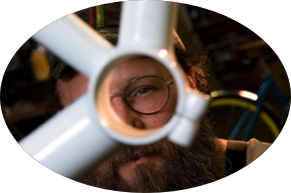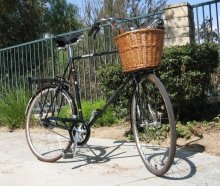 When I asked him about the ideal role of bicycles in today’s transportation picture, he told me about his longtime interest in community design. He sent me a link to a 180-page document on which he was the lead author, entitled, “Community Design for Optimal Energy and Resource Utilization.” Bilenky won a National Science Foundation grant to do the research for this paper while he was a student at Pennsylvania State University. We might conclude that Bilenky has put a considerable amount of thought into this question.
When I asked him about the ideal role of bicycles in today’s transportation picture, he told me about his longtime interest in community design. He sent me a link to a 180-page document on which he was the lead author, entitled, “Community Design for Optimal Energy and Resource Utilization.” Bilenky won a National Science Foundation grant to do the research for this paper while he was a student at Pennsylvania State University. We might conclude that Bilenky has put a considerable amount of thought into this question.Not all of us might be thrilled at the idea of riding our bikes underground, but perhaps living in Southern California has made me forget what riding through East Coast winters is like. And you have got to respect someone who dares to “dream big.” I certainly agree with his assertion that, “If it [our transportation infrastructure] is not shaped for cycling, how are people going to surmount the barriers?”
I asked him about his recommendations for off-the-shelf bicycles. “The Somas are nice. The Surlies are okay.” He told me he liked the purpose-built Surlies, such as the Pugsley and Big Dummy. He did opine that the Surlies “are a little heavier than they need to be.”
He also added, “Trek has a lot of decent bikes.”
In terms of used bikes, he told me, “I have a fond spot for late 70s/early 80s Japanese touring bikes. Nishikis, Fujis, Panansonics, some of the early [Asian-built] Raleighs.”
We chatted about the American framebuilders who barely make enough money to survive. I asked him if he thought it would be possible for a USA-based bicycle manufacturer to become profitable enough to pay its employees competitive wages. “There are a lot of ingredients, but a key one is the scale of operations. One to two people have such high overhead that it is hard to make stuff and sell stuff and organize stuff, etc. It would have to be very premium priced.”
He talked about bicycle companies such as I.F., Seven or Comotion as being big enough to potentially succeed, while not being too big to maintain manufacturing only in the USA. He pointed at Cannondale as an example of a company that outgrew the viable size limitations and had to outsource some of its production to China after experiencing severe financial problems.
Bilenky is still trying to find the right size for BCW. Currently, there are eight people working for the company, but with demand for BCW products surging, that number might need to grow in the near future. At this point in 2008, they are looking for 50% growth over last year. In the next month or so, they will start production of their biggest batch of cargo bikes ever. They have already sold three times as many cargo bikes in 2008 as they sold in all of 2007. In Europe, the devaluation of the US dollar has made American-made bicycles amazing bargains. BCW has taken advantage of this trend and has gotten good exposure in EU countries.
Additionally, the revolution in electronic communications has left bicycle messengers feeling squeezed. Since important documents can now be scanned and sent via e-mail, messengers must find new services which cannot be provided electronically. One such service is the hauling of cargo. Need to haul twenty reams of copier paper across town? A BCW cargo bike can get your paper there with aplomb.
 The new BCW "Rear John" cargo bike
The new BCW "Rear John" cargo bikePhoto courtesy of Moving Target Zine with some rights reserved
And there are new cargo bike models coming from BCW in the very near future! In addition to the models I mentioned in Part One of this series, BCW is also developing other alternatives. Bilenky seemed most excited about the bike he referred to as the “Rear John,” as opposed to the “Long John,” which is how he described the style of his traditional, front-loaded cargo bikes. The Rear John, also known as the “8 Freight,” features a large cargo rack behind the rider. The rack is low to the ground for stability and control. BCW introduced their first prototype of this style at the Cycle Messenger World Championships in Toronto a few weeks ago. The bike impressed many, including the bicycle messenger e-zine “Moving Target,” which called it “shockingly light.”
Bilenky is also developing a version of the “Viewpoint” tandem in which the front, recumbent rider is replaced by a cargo area. Additionally, BCW is experimenting with electric assist options for cargo hauling and a center stand which will mount to pre-installed braze-ons under the front wheel. This stand will lift the front wheel slightly off the ground and provide an extremely sturdy, stable platform when the bicycle is parked.
As we wrapped up our conversation, Bilenky talked about the preparations BCW was making for the 2008 Cirque du Cyclisme which occurred the weekend after we spoke. As he spoke of all the bicycles he was preparing as well as the presentation he was going to give, I felt that I was getting a real glimpse into this man’s life. We think of framebuilders as craftsmen or artisans. Stephen Bilenky is both of those things, and so much more. He is a scholar, a businessman, a social scientist and an ambassador for practical bicycles. He has dedicated his life to doing something he believes in and doing it well. He has both my respect and my gratitude.

















